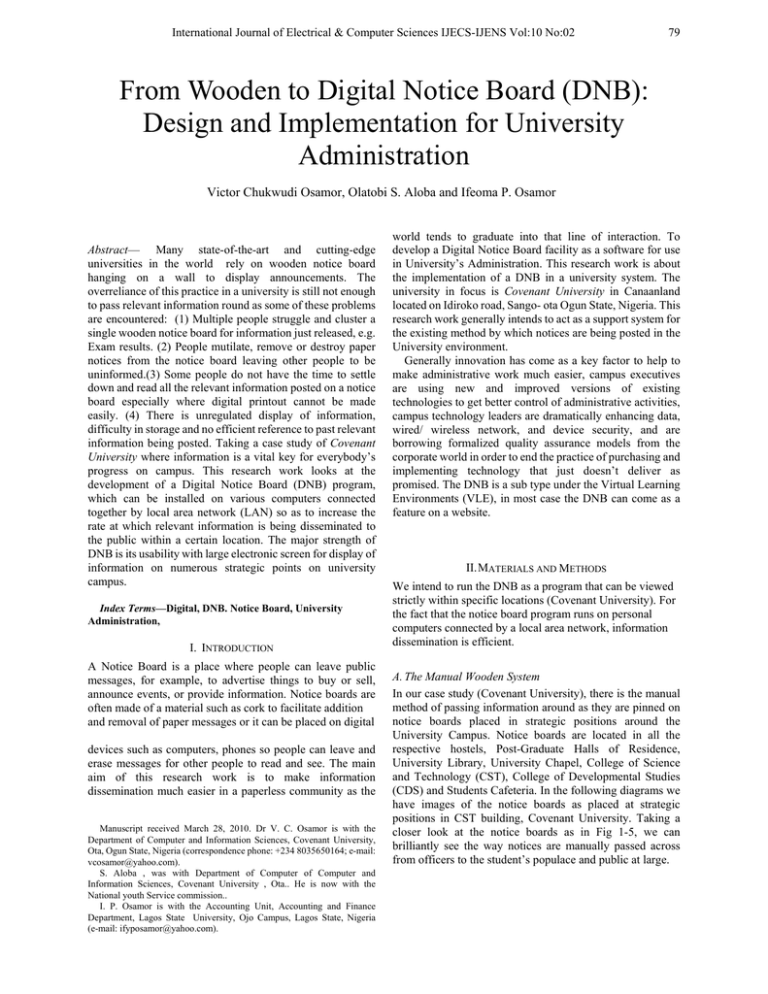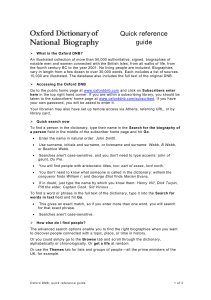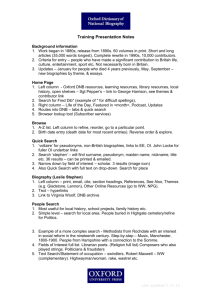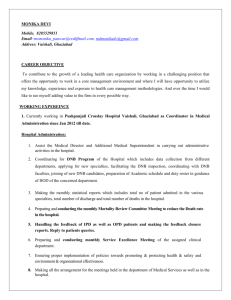From Wooden to Digital Notice Board
advertisement

International Journal of Electrical & Computer Sciences IJECS-IJENS Vol:10 No:02 79 From Wooden to Digital Notice Board (DNB): Design and Implementation for University Administration Victor Chukwudi Osamor, Olatobi S. Aloba and Ifeoma P. Osamor Abstract— Many state-of-the-art and cutting-edge universities in the world rely on wooden notice board hanging on a wall to display announcements. The overreliance of this practice in a university is still not enough to pass relevant information round as some of these problems are encountered: (1) Multiple people struggle and cluster a single wooden notice board for information just released, e.g. Exam results. (2) People mutilate, remove or destroy paper notices from the notice board leaving other people to be uninformed.(3) Some people do not have the time to settle down and read all the relevant information posted on a notice board especially where digital printout cannot be made easily. (4) There is unregulated display of information, difficulty in storage and no efficient reference to past relevant information being posted. Taking a case study of Covenant University where information is a vital key for everybody’s progress on campus. This research work looks at the development of a Digital Notice Board (DNB) program, which can be installed on various computers connected together by local area network (LAN) so as to increase the rate at which relevant information is being disseminated to the public within a certain location. The major strength of DNB is its usability with large electronic screen for display of information on numerous strategic points on university campus. Index Terms—Digital, DNB. Notice Board, University Administration, I. INTRODUCTION A Notice Board is a place where people can leave public messages, for example, to advertise things to buy or sell, announce events, or provide information. Notice boards are often made of a material such as cork to facilitate addition and removal of paper messages or it can be placed on digital devices such as computers, phones so people can leave and erase messages for other people to read and see. The main aim of this research work is to make information dissemination much easier in a paperless community as the Manuscript received March 28, 2010. Dr V. C. Osamor is with the Department of Computer and Information Sciences, Covenant University, Ota, Ogun State, Nigeria (correspondence phone: +234 8035650164; e-mail: vcosamor@yahoo.com). S. Aloba , was with Department of Computer of Computer and Information Sciences, Covenant University , Ota.. He is now with the National youth Service commission.. I. P. Osamor is with the Accounting Unit, Accounting and Finance Department, Lagos State University, Ojo Campus, Lagos State, Nigeria (e-mail: ifyposamor@yahoo.com). world tends to graduate into that line of interaction. To develop a Digital Notice Board facility as a software for use in University’s Administration. This research work is about the implementation of a DNB in a university system. The university in focus is Covenant University in Canaanland located on Idiroko road, Sango- ota Ogun State, Nigeria. This research work generally intends to act as a support system for the existing method by which notices are being posted in the University environment. Generally innovation has come as a key factor to help to make administrative work much easier, campus executives are using new and improved versions of existing technologies to get better control of administrative activities, campus technology leaders are dramatically enhancing data, wired/ wireless network, and device security, and are borrowing formalized quality assurance models from the corporate world in order to end the practice of purchasing and implementing technology that just doesn’t deliver as promised. The DNB is a sub type under the Virtual Learning Environments (VLE), in most case the DNB can come as a feature on a website. II. MATERIALS AND METHODS We intend to run the DNB as a program that can be viewed strictly within specific locations (Covenant University). For the fact that the notice board program runs on personal computers connected by a local area network, information dissemination is efficient. A. The Manual Wooden System In our case study (Covenant University), there is the manual method of passing information around as they are pinned on notice boards placed in strategic positions around the University Campus. Notice boards are located in all the respective hostels, Post-Graduate Halls of Residence, University Library, University Chapel, College of Science and Technology (CST), College of Developmental Studies (CDS) and Students Cafeteria. In the following diagrams we have images of the notice boards as placed at strategic positions in CST building, Covenant University. Taking a closer look at the notice boards as in Fig 1-5, we can brilliantly see the way notices are manually passed across from officers to the student’s populace and public at large. International Journal of Electrical & Computer Sciences IJECS-IJENS Vol:10 No:02 80 Figure 4: Notice Board (41.6cm by 90.5cm) at the Staff Office Entrance; 1st Floor CST Building Figure 1: Notice Board (41.8cm by 88.1cm) at the left section of the Ground Floor Reception Desk, CST Building Figure 2: Notice Board (48.0cm by 44.5cm) at the left-end of the Ground Floor Reception Desk, CST Building Figure 3: Notice Board (41.8cm by 88.1cm) at the right side of the Ground Floor Reception Desk, CST Building Figure 5: Notice Board (42.5cm by 42.8cm) at the Class Entrance; 1st Floor CST Building The notice board is a flat solid object placed at strategic positions makes it an object which notices and posters are being placed on it. In Covenant University, notices spring up from different officers bringing reminders, warnings, advice, results, and appointments to be placed on the notice board. As these notices are being placed on the boards, some of the old notices are not removed and with time the notice boards get filled up with relevant and irrelevant notice messages, as a result of this, a person might not take caution of any new notice being displayed as the person feels he cannot go through the stress of browsing through the whole notice board searching for relevant notices. This can be found about the notices placed in the figures above. It is obvious that developing DNB program would help in disseminating information much easier between different members of the university. B. Proposed Architecture and Design The proposed system architecture are depicted in Fig 6. Unified Modeling Language (UML) is a standardized specification language for object modeling [1]. UML is a general-purpose modeling language that includes a graphical notation used to create an abstract model of a system, referred to as a UML model. Figure 6 describes the DNB system where the Principal, Faculty or Non-academic officers, have privileges to create an account, update notice and delete an account while the user has privileges to view and print updated notices from the Principal, Faculty and Non-Academic officers as in Fig 7a. The User (Actor) is anybody who intends to read notice on the DNB and request for updated Notice: The User as in Fig 7b is connected to the DNB through LAN, he reads the updated notice and can also print the notice from his individual location. Here are the steps the user takes in the DNB use-case [2]: • After the user has been connected to the DNB through LAN. • Checks for updated notice and has the privilege to print the updated notice. • Exit Application International Journal of Electrical & Computer Sciences IJECS-IJENS Vol:10 No:02 81 1 Add/delete account 2 Add/delete notice (Principal) CLIENT 1. Add/delete account DIGITAL NOTICE BOARD 2. Add/delete notice (Faculty) SERVER Notice is stored in the Database server Retrieves notice from Database server DATABASE 1. Add/delete account 2 Add/delete notice (Non-Academic) Read notice Print Notice User Figure 6: Proposed System Architecture for Digital Notice Board (DNB) OFFICER GUI SCREEN DATABASE USER GUI SCREEN DATABASE SIGNUP ACCOUNT VIEW NOTICE EDIT/DELETE ACCOUNT PROCESS REQUEST PRINT NOTICE PROCESS REQUEST NOTICE UPDATE DELIVER REQUEST DELIVER REQUEST UPDATE OFFICER Figure 7a: Activity Diagram of Officer’s actions UPDATE USER Figure 7b: Activity Diagram Showing the User’s actions International Journal of Electrical & Computer Sciences IJECS-IJENS Vol:10 No:02 82 Figure 8: A Sample Screen of DNB User Interface C. Modules and System Requirements JAVA was used as the front-end or client side of the package to enhance interactivity, simplicity and to give a beautiful user-friendly interface. Microsoft Access, a relational database management system was also used as the back-end. When the program is launched, the person using the program is welcomed with a main screen which provides all the menu options that may be selected to enter or access the other modules including the module of study. This allows for easy navigation of the system, since it is an easily understandable GUI as in Fig. 8. The following modules are divided into the activities that are performed by the Officers and Users as listed below: • Principal Account Signup • Faculty Account Signup • Non-Academic Account Signup • Principal Edit/Delete • Faculty Edit/Delete • Non-Academic Edit/Delete • Update Principal Notice • Update Faculty Notice • Update Non-Academic Notice For an effective and hitch free operation of the DNB the program requirements are: • Microsoft® Windows® XP, 2000 or NT 4.0 or higher • JRE(Java Runtime Environment) • Java 2 software development toolkit (J2SDK version 1.4.1) or J-Builder X Enterprise to run the package. • Microsoft Access relational database management system • • • • • • • • • to access the database. Intel® Pentium® III 500 MHz or compatible or higher 128 MB of RAM or higher 4GB Hard disk or higher An SVGA Monitor with a brilliant graphic card Keyboard and Mouse Printer Large Electronic Display Units UPS (Uninterruptible Power Supply) Air conditioned room for the Application Server International Journal of Electrical & Computer Sciences IJECS-IJENS Vol:10 No:02 83 III. RESULT AND DISCUSSION IV. CONCLUSION Since the notice board program runs on personal computers connected by a local area network, the following results are obtainable benefits: The readers can read the notices being posted from anywhere within the campus just as long as the computer is connected through the local area network (LAN) facility [3, 4]. It acts as a medium for a quick reminder to the readers about upcoming events. The officer posting the notice can post it from anywhere within the campus as long as he has the authorized access. Notices that have expired can be referred to as they are stored in the database for a long period of time. In some cases most people do not find the notice that has been posted on the board due to the selfish interest of some people removing them for their personal use, the DNB acts as a medium where people can people can view relevant notices over time. Some of the notices being pinned on the notice board cannot be viewed clearly as they are sometimes handwritten, the notices in a DNB are being typed in hence the reader can view them very clearly. The developed DNB package is a lightweight application that may not meet up to the standard of an effective DNB application, but it is fully capable of passing relevant notice and announcements across. Due to this detail, it can be set up and operated in a few steps which are: The Java Development Kit has to be installed on the system(s) that the program will be deployed. The j2sdk can be downloaded from the website at www.sun.com. After installation of the Kit, the class path has to be set (this enables the program to run without going through the java file). The class path is added by clicking the start menu on the windows task bar then, click the control panel option, double-click the system option, select the “advanced” tab in the system option, in the advanced tab, click the environment variables button and adds the class path on the “user and system” variable field in the environment variables window. When the Java Software Development Kit is installed, it is necessary to create a DSN (Data Source Name) to connect the program to the Microsoft Access database (backend). The name of the database file is “Notice_Board.mdb” and the process for creating the data source name is as follows: Step 1 From the Start Menu, select Control Panel Step 2 Select the Administrative Tools Option in the Control Panel Step 3 Double Click on the Data Sources (ODBC) Shortcut Step 4 In the Data Sources Administrator window, click the Add button and select the Microsoft Access driver (*.mdb) option and click Finish. Step 5 In the ODBC Microsoft Access Setup window, enter “Notice_Board” in the Data Source Name text field. Click on select in the database sub-option and locate the “Notice_Board.mdb” file. Click OK. With that accomplished, the program can now run. Run Command prompt or MS-DOS Prompt and enter the path where the system files are stored. Compile the “Notice_Board.java” file and run the program by using the java command on the same file. For Example: C:\Program Files\Java\j2sdk1.5.0_05\bin> javac Splash.java ((file name where programming language is stored and java compile command). The deployment of our DNB software brings an advanced means of passing notices around in the University. It has the capability to disseminate notices in a simple and well organized manner compared to the existing paper-based notice board system. With the use of the DNB, human traffic will be reduced at notice board locations since information on notice boards can be accessed digitally on any DNB-installed computer. In addition, people will be able to print out multiple copies of any posted notices. Besides, the output can be displayed on large electronic board with organized circuitry. This was demonstrated in Villar et al. [5] by equipping physical notice board with digital logic and display. Security of notice placement is guaranteed as the officers posting notices have an assigned key to do so. In general, the DNB will result as an improvement over the existing notice boards used in for University Administration. ACKNOWLEDGMENT We wish to thank Covenant University for the information and platform provided especially as a case study university to carry out this work. REFERENCES [1] S. W. Ambler, “The Object Primer: Agile Model Driven Development with UML 2”, Cambridge University Press, 2004. [2] K. Bittner, I. Spence, Use Case Modeling. AddisonWesley Professional, 2002 [3] F. Halsall. “Data Communication, Computer Networks and Open Systems (4th Edition )”, Addison Wesley Publishers Limited, 1996. [4] J. Callaghan, “ Inside Intranets and Extranets: Knowledge Management and the Struggle for power”. Palgrave Macmillian, 2002 [5] N. Villar, K. Van Laerhoven, H.-W. Gellersen. "A Physical Notice Board with Digital Logic and Display" (Demo). In Adjunct Proceedings of the European Symposium on Ambient Intelligence 2004; ACM ISBN: 1-58113-992-6. pp. 207-217. 1. Dr V.C. Osamor. has a Ph.D in Computer Science and Bioinformatics. He is currently a lecturer in the Department of Computer and Information Sciences, Covenant University, Ota, Ogun State, Nigeria. (e-mail: vcosamor@gmail.com). He is a member of Nigerian Computer Society (NC and Computer Professionals (Registration Council) of Nigeria (CPN). 2. Mr S. Aloba, obtained his B.Sc in Management Information System from Covenant University, Ota, Ogun State, Nigeria. He has completed his National Service with the Directorate of National Youth Service Commission (NYSC) in Nigeria. 3. I. P. Osamor is a chartered accountant with the Accounting and Finance Department, Lagos State University, Ojo, Lagos, Nigeria. (e-mail: ifyposamor@yahoo.com).



